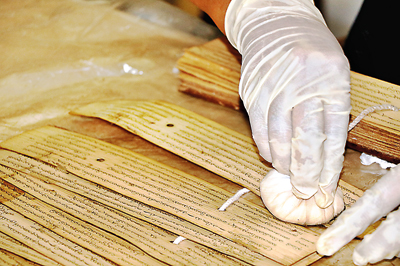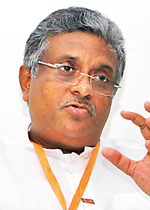Ancient manuscripts from around the country under one roof

Preserving for posterity: Gaduba tree ash mixed with resin oil. Pix by Priyanka Samaraweera
Ancient palm leaf manuscripts neatly tied up, treated with citronella oil, a natural insect repellent and laid on cotton cloth are stored in a wooden cupboard. Carrying the secrets of Sri Lanka’s indigenous medicine which had been passed from generation to generation, this valuable collection is safely housed in the Lanka Room of the library of the University of Sri Jayewardenepura.
The Palm-leaf Manuscript Preservation and Conservation Project, an initiative of the library committee of the University of Sri Jayewardenepura under the patronage of the Vice Chancellor, Prof. Sampath Amaratunge invites the general public to donate palm- leaf manuscripts they have in their possession to the university library, to be preserved and maintained as an academic collection.
Dr. Nayana Wijayasundara, Librarian, University of Sri Jayewardenepura, one of the pioneers of the project explains that the history of Sri Lankan palm-leaf manuscripts dates back to the 18th and 19th centuries where dried strips of palm leaf were used to record the teachings of Lord Buddha, indigenous medicines and remedies for human and animal illnesses along with Sri Lankan exorcism rituals.
The university library has a collection of 20 palm-leaf manuscripts, which had been in the university library since its inception in 1959, mostly comprising indigenous medicine and remedies, and a few on Buddhism.

Prof. Sampath Amaratunge
“We are receiving positive feedback from all around the country, from Anuradhapura, Diyathalawa, Kurunegala and Kandy. People want to donate the manuscripts as they know that once they are given to a university they will be well preserved and they will be open to the whole of the country,” says Dr.Nayana.
“The University of Sri Jayewardenepura having nearly 14,000 undergraduates has a proud history dating back to 1873 when Hikkaduwe Sri Sumangala Thera established the Vidyodaya Pirivena when Buddhism was at a low ebb under British colonial rule. As a leading national university we have a national responsibility towards restoring our ancient wisdom, introducing it to the younger generations and hence take our heritage to the world,” said Vice Chancellor Prof. Sampath Amaratunge, whose vision it was to initiate the project.
The collection carries the names of the owner and the donor of the manuscripts attached to the copies. “It’s as a gesture of appreciation, and anyone would know to which family the manuscript belonged and that it was treasured for hundreds of years within the family,” says Dr. Nayana.
The library is looking to digitize the manuscripts in the near future, for easy reference.

Dr. Nayana Wijayasundara
“It took nearly six months for us to complete the conservation of the 20 manuscripts. At the moment we have received around 200 palm-leaf manuscripts under the project,”Menaka Nishanthi, Assistant Librarian, in charge of the Preservation and Conservation Unit notes.
Nilmini Neththasinghe, Museum Curator, Department of History and Archaeology, Faculty of Humanities and Social Sciences, University of Sri Jayewardenepura provided her expertise in preserving the
palm-leaf manuscripts having worked for 13 years in the Department of National Museum as Head of the Conservation Division and Conservation Office.
In conserving palm- leaf manuscripts, unique techniques are followed for each part of the document – two wooden hard covers (Kamba), the code (Huya), Washer like part which secures the code (Sakiya),and palm leaves (Path Iru). “Kamba were restored with Neem wood (Kohomba), a natural insect repellent, and old codes were replaced with cotton codes,” explains Nilmini.
Palm leaves have a certain flexibility but exposed to climatic changes, the leaves become dry and prone to breakage. The application of Dummala Thel makes the leaf flexible again. If the letters are faded, ash of the Gaduba tree mixed with resin oil is applied with cloth so that the black ash would stick onto the letter carvings.
To patch up the holes in palm leaves Carboxymethyl cellulose (CMC) is used as an adhesive to make a paste with Japanese acid free tissues. “Conservation takes time and attention. For me it’s like a meditation,” Nilmini says with much enthusiasm.
| If you like to donate | |
| The Palm-leaf Manuscript Preservation and Conservation Project is an ongoing project. Manuscripts can be donated to the Library, University of Sri Jayewardenepura, Gangodawila, Nugegoda. For more details contact Dr. Nayana Wijayasundara on 0112804194 or email librarian@sjp.ac.lk. |


